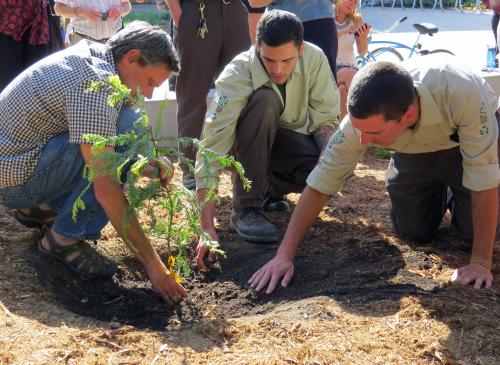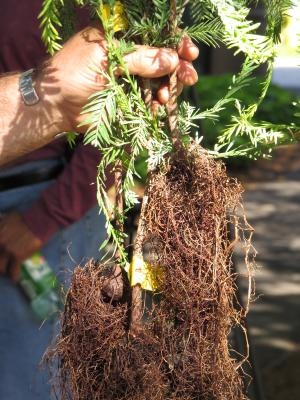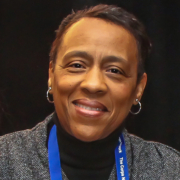

College of Marin Gardener Rodney Craig, left, and students from the Conservation Corps North Bay, plants a coast redwood saplings cloned from some of the largest ancient trees in the world on Monday, April 22, at the College of Marin. College of Marin is one of eight locations in the world and the only location in the U.S. to receive the plantings in a global event spearheaded by the Archangel Ancient Tree Archive. Earth Day plantings will also take place in British Columbia, Ireland, Australia, Wales, New Zealand, Germany and England. (College of Marin photo/Shook Chung)
The College of Marin, a partner of Conservation Corps North Bay, is one of eight locations worldwide participating in an effort to expand the distribution Giant Redwood trees.
Taken from the Marin Independent Journal, marinij.com
The College of Marin became a focal point Monday as part of an effort by a nurseryman from northern Michigan and his sons who have snipped branches from some of the world’s biggest and most durable trees with plans to produce clones that could restore ancient forests and help fight climate change.
Now comes the most ambitious phase of the quest: getting the new trees into the ground.
Ceremonial plantings of two dozen clones from California’s mighty coastal redwoods took place Monday in seven nations: Australia, New Zealand, Great Britain, Ireland, Canada, Germany and in the United States at the College of Marin as part of its Earth Day observance.
“I know the trees will thrive here,” said Tom Burke, landscape manager at the College of Marin. “We’ve had redwoods in this area since God planted them.”
The three small sprouts, arriving in hollow carpet tubes for their protection, were planted by students in the Redwood Grove on campus during a ceremony.
Among the speakers was broadcast journalist Dana King, a former CBS news anchor who serves on the board of directors of the Archangel project.
“This is a really simple thing to do — to plant trees to help the environment,” said King, noting the college was selected because of its existing trees. “If we want to start to reverse climate change, we can start by planting a tree.”
Although measuring just 18 inches tall, the laboratory-produced trees are genetic duplicates of three giants that were cut down in Northern California more than a century ago. Remarkably, shoots still emerge from the stumps, including one known as the Fieldbrook Stump near McKinleyville, which measures 35 feet in diameter. It’s believed to be about 4,000 years old. The tree was about 40 stories high before it was felled. 
“This is a first step toward mass production,” said David Milarch, co-founder of Archangel Ancient Tree Archive, a nonprofit group spearheading the project. “We need to reforest the planet; it’s imperative. To do that, it just makes sense to use the largest, oldest, most iconic trees that ever lived.”
Milarch and his sons Jared and Jake, who have a family-owned nursery in the village of Copemish, Mich., became concerned about the condition of the world’s forests in the 1990s. They began crisscrossing the U.S. in search of “champion” trees that have lived hundreds or even thousands of years, convinced that superior genes enabled them to outlast others of their species. Scientific opinion varies on whether that’s true, with skeptics saying the survivors may simply have been lucky.
The Archangel leaders say they’re out to prove the doubters wrong. They’ve developed several methods of producing genetic copies from cuttings, including placing branch tips less than an inch long in baby food jars containing nutrients and hormones. The specimens are cultivated in labs until large enough to be planted.
In recent years they have focused on towering sequoias and redwoods, considering them best suited to absorb massive volumes of carbon dioxide, the greenhouse gas primarily responsible for climate change.
“If we get enough of these trees out there, we’ll make a difference,” said Jared Milarch, the group’s executive director.
Archangel has an inventory of several thousand clones in various stages of growth that were taken from more than 70 redwoods and giant sequoias. NASA engineer Steve Craft, who helped arrange for David Milarch to address an agency gathering, said research shows that those species hold much more carbon than other varieties.
The challenge is to find places to put the trees, people to nurture them and money to continue the project, Jared Milarch said. The group is funded through donations and doesn’t charge for its clones.
The recipients of Archangel redwoods have pledged to care for them properly, he said. The first planting of about 250 took place in December on a ranch near Port Orford, Ore.
“A lot of trees will be planted by a lot of groups on Arbor Day, but 90 percent of them will die,” David Milarch said. “It’s a feel-good thing. You can’t plant trees and walk away and expect them to take care of themselves.”


































































